The Panthéon, an imposing 19th century building, was first designed as a church, but later turned into a civil temple.
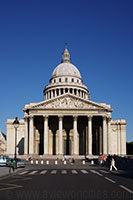
Conception
When King Louis XV suffered from a serious illness in 1744 he vowed to build a church dedicated to Sainte-Geneviève
if he would survive. After he recovered, he entrusted
the Marquis of Marigny with the task of building the
church, which was to replace the 6th century basilica,
at the time known as the Abbey Sainte-Geneviève.
In 1755, the Marquis commissioned
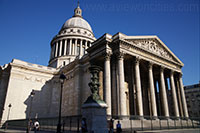 architect Jacques- Germain
Soufflot to design a new, great church.
architect Jacques- Germain
Soufflot to design a new, great church.
In 1755, the Marquis commissioned

Construction
Construction of the imposing building
started in 1757. Mainly due to financial problems, it would take 34
years until the project was completed.
After Soufflot's death in 1780, his associate
Guillaume
Rondelet took charge of the project. The
building was
finished in 1791, in the midst of the French
Revolution.
That same year, the Constituent
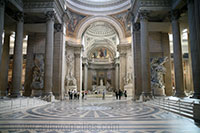 Assembly of the Revolution
decided by decree to transform the church into a temple
to accommodate the remains of the great men of France.
The building was adapted by architect Quatremère
de Quincy to its new function as a pantheon.
Assembly of the Revolution
decided by decree to transform the church into a temple
to accommodate the remains of the great men of France.
The building was adapted by architect Quatremère
de Quincy to its new function as a pantheon.
In 1806 the building was turned into a church again, but since 1885 the Panthéon serves as a civic building.
That same year, the Constituent

Interior of the Panthéon
In 1806 the building was turned into a church again, but since 1885 the Panthéon serves as a civic building.
The floorplan shows a Greek-cross layout,
110m long and 85m wide (361 x 279 ft). The large dome reaches a height
of 83m (279ft).
The portico, with large Corinthian columns was
modeled
after the 2nd century Pantheon
in Rome.
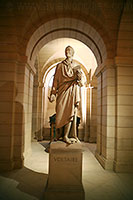 The dome features
three superimposed shells, similar to the St. Paul's Cathedral in London.
Iron reinforcements were added to strengthen the structure
even more.
The dome features
three superimposed shells, similar to the St. Paul's Cathedral in London.
Iron reinforcements were added to strengthen the structure
even more.

The Crypt - Voltaire
Crypt
The large crypt, covering the whole surface of the building accommodates the vaults of great French public figures.
Some of the most famous buried here are Victor Hugo, Voltaire,
Jean Monnet, Marie and Pierre Curie and Emile
Zola.
Foucault's Pendulum
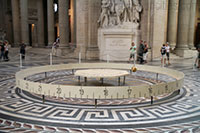
Foucault's Pendulum
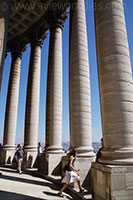
The dome's colonnade
Views
From the colonnade around the building's
dome, you have an excellent view over Paris. For safety issues you can
only go up there in company of a (free) guide at regular hours. The
Panthéon itself
is best seen coming from the Jardin
du luxembourg through the rue Soufflot.
No comments:
Post a Comment